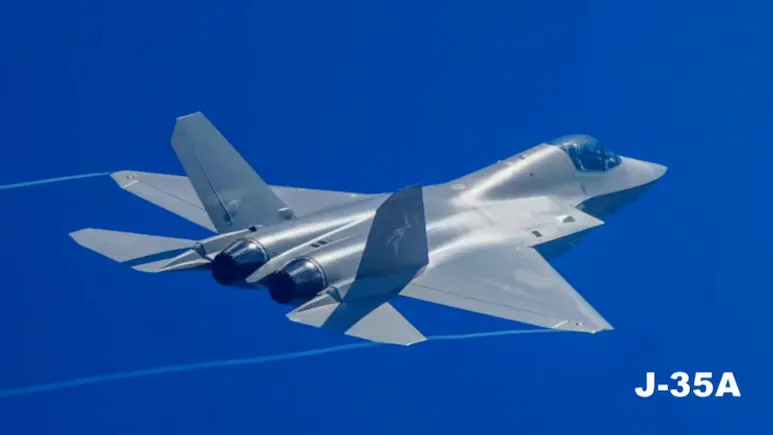New Delhi – Emerging Threats in South Asia’s Aerial Landscape
As geopolitical tensions escalate in South Asia, the recent announcement regarding Pakistan’s acquisition of Chinese-made J-35 stealth fighters has raised significant alarms within India’s defense circles. In November 2024, China officially introduced the J-35, its second generation of fifth-generation stealth fighter jets. This twin-engine, single-seat supersonic aircraft is engineered for multirole missions and is equipped with cutting-edge technology, including advanced avionics and an active electronically scanned array (AESA) that enhances its combat capabilities.
Pakistan aims to procure around 40 J-35s, with the first jets expected to be operational by late 2025. With this acquisition, Pakistan will join a select group of countries capable of deploying stealth fighter technology, subsequently altering the balance of air power in the region. India’s concern stems from the fact that it currently lacks an operational stealth fighter of its own. This development poses a challenge to India’s long-standing air superiority, an advantage that has been critical in regional conflicts and strategic deterrence.
Factors Behind India’s Concerns
The J-35, often described as a “black box” due to limited publicly available data on its capabilities, is perceived to be on par with, or potentially superior to, the United States’ F-35 jets. While the J-35 has not been tested in combat, its stealth capabilities—specifically a radar cross-section of just 0.001 square meters—are anticipated to make it exceedingly hard for Indian radar and air defense systems to detect it during incursions or aerial engagements.
Moreover, this air superiority shift is alarming, as it is expected that Pakistan will utilize these fighters not only for air-to-air combat but also as a platform for coordinating strikes involving surface-to-air missiles and other weapon systems. As per the report by Global Times, the capabilities of this jet could reshape the air combat dynamics, placing severe pressure on India’s existing air defense infrastructure.
With the double threat of both Pakistan and China operating advanced stealth fighters, experts warn that India’s national security could face unprecedented challenges. The integration of these aircraft into Pakistan’s Air Force could significantly disrupt India’s strategic calculations, especially in potential multi-front conflict scenarios.
The Need for Urgent Reforms in India’s Air Defense Strategy
India’s defense establishment is becoming increasingly aware that it must expedite efforts to bridge the air power gap. The Indian Ministry of Defence is currently focused on enhancing its existing air defense systems while also fast-tracking the development of its own fifth-generation stealth fighters, notably the Advanced Medium Combat Aircraft (AMCA).
However, the AMCA, even after its recent clearance by Defense Minister Rajnath Singh, is not expected to be operational until at least 2035. This significant delay puts India at a disadvantage while Pakistan forges ahead with its acquisitions. Experts stress the importance of a “national mission mode push” to expedite the AMCA project, underscoring the urgency for India to modernize its air power capabilities.
Despite their historical edge regarding air superiority, India cannot afford complacency—especially with Pakistan’s imminent integration of stealth jet technology. Recent acquisitions, such as the French Rafale fighter jets, have bolstered Indian capabilities, but these improvements may not be sufficient to counterbalance the incoming threats posed by stealth aircraft.
India’s Strategic Dilemma
Group Captain Ajay Ahlawat (retd.), a seasoned fighter pilot, highlighted the pressing concerns rising from Pakistan’s stealth jet acquisition. He conveyed, “Any version of the J-35 in Pakistani colors is going to raise concerns for our side.” The potential of these jets to alter air combat scenarios means India must critically assess its strategic options moving forward. While options existed for India to purchase advanced fighter jets like the F-35 or Russian Su-57, experts have termed those as “bad choices,” advocating instead for a swift deliverance of the indigenously developed AMCA.
India’s responses must be multi-faceted—upgrading existing defensive measures while also investing in advanced fighter programs that can assure aerial dominance. The air defense networks must be enhanced to withstand the sophisticated threats that J-35 jets could pose.
Looking Ahead: Strategies for India’s Aerial Superiority
In light of these developments, it is imperative for India to undertake comprehensive strategic planning. This entails not only technological advancements but also diplomatic channels to mitigate any escalation of conflict. Enhanced collaborations with other nations could open avenues for joint ventures and technology sharing that can benefit India’s defense capabilities.
Moreover, initiatives to bolster indigenous military manufacturing can foster greater self-reliance, reducing dependence on foreign technology while cultivating a robust ecosystem for defense innovation.
Ultimately, the J-35 acquisition by Pakistan marks a turning point in South Asian military dynamics. Without proactive measures and a commitment to rapid modernization, India risks conceding its historical air superiority to its regional rivals.
For further insights into India’s aviation strategies and developments, click on these articles about India’s National Defense Policies and Global Defense Trends.
The future of air power in the region will hinge on how effectively India adapts to these emerging threats while innovating its combat strategies for the years to come.
DISCLAIMER
We have taken every measure to ensure that the information in this article and on our social media platforms is accurate, verified, and obtained from reliable sources. For feedback or complaints, please contact us at info@hamslive.com.


